What Is Multichannel Customer Service: Channels & Tips
Multichannel customer service is a strategy that involves providing support and assistance to customers across multiple communication channels such as phone, email, live chat and social media.

Multichannel customer service is a strategy that involves providing support and assistance to customers across multiple communication channels such as phone, email, live chat and social media.

Customers expect instant and efficient service across multiple channels. 86% of consumers anticipate consistent communication across multiple channels. Are you keeping up with the demands of multichannel customer service?
Owing to the rise of social media, chatbots, email and phone support, customers have more options than ever to reach out for assistance. Businesses need to understand the importance of providing seamless and consistent support across all channels.
Multichannel customer support is the new standard for businesses looking to stay competitive in the market. Companies must embrace a strategy that integrates various communication channels to provide a seamless and effective customer service experience.
Multichannel customer service can be defined as a strategy that businesses use to interact with customers through multiple communication channels such as phone, email, social media, live chat and more. Businesses can provide a seamless and convenient customer service experience. It leads to higher customer satisfaction by offering customers the ability to reach out through various channels. The key to successful multichannel customer support is ensuring consistent and efficient support across all channels.
Top-notch service across multiple channels is essential for any business looking to provide superior customer support. Here are five multichannel customer service importance to understand why multichannel support is important for the business:
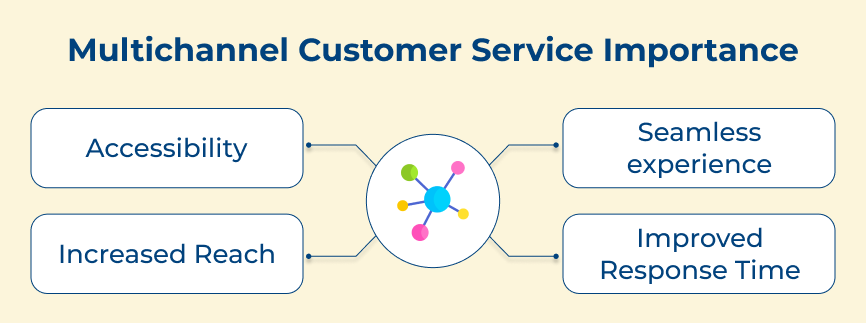
1. Accessibility: Offering multiple channels for customer service such as phone, email, live chat, social media and messaging apps allows businesses to make it easier for customers to reach out to them. It allows customers to choose the most convenient channel for them, leading to higher customer satisfaction.
2. Seamless experience: Providing consistent support across all channels ensures a seamless experience for customers. Whether a customer reaches out via phone or social media, they expect the same level of service and information. Integrating all channels and maintaining a unified approach allows businesses to create a cohesive customer service experience.
3. Increased reach: Not all customers prefer to communicate through the same channel. Organizations can reach a wider audience and cater to different preferences by offering multiple channels. Its increased reach can help businesses connect with more customers and address their needs effectively.
4. Improved response time: A multichannel customer support strategy allows for quicker response times, as organizations can address customer inquiries in real-time across various platforms. Monitoring all channels and responding promptly allows businesses to enhance customer satisfaction.
Understanding the pros and cons of each channel allows businesses to create a multi-channel customer support strategy that meets the needs of their customers. Here we will explore the different channels for providing excellent customer service, from traditional methods like phone or email to newer technologies.
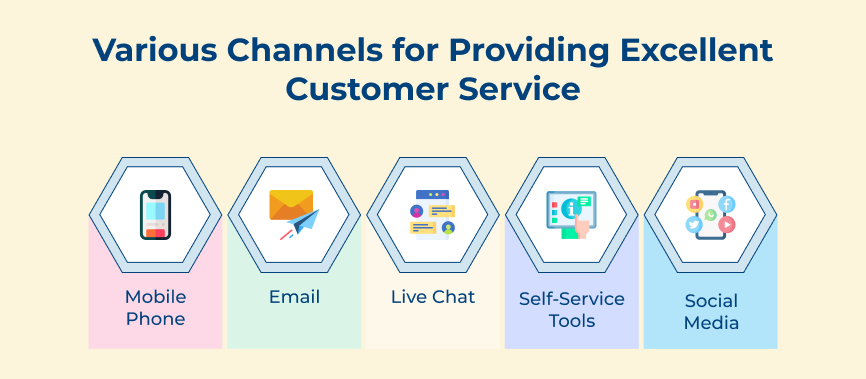
Mobile phones have become one of the most important channels for providing excellent customer service. The rise of smartphones allows customers to easily reach businesses through calls, texts, emails, social media and even live chat features on mobile apps. 55% of customers prefer to seek customer support through mobile apps.
Mobile phones increase customer satisfaction by providing quick resolutions to issues, personalized interactions and convenience. Businesses that prioritize mobile customer service can stand out from competitors and build stronger relationships with their customers. Businesses need to leverage mobile phones as a key channel for providing excellent customer service.
Email has long been a staple in customer service, serving as one of the various channels for providing excellent customer support. Owing to its asynchronous nature, customers can easily reach out to businesses at any time and businesses can respond when it is convenient for them. It also provides a written record of the communication, which can be helpful for both customers and businesses to refer back to.
Email plays a crucial role in providing a seamless experience across different touchpoints. Integrating email with other channels such as phone support, live chat and social media allows businesses to meet their customers where they are to provide efficient support.
Live chat is a popular channel for providing excellent customer service. It allows customers to interact with businesses in real time through text-based messaging on websites or mobile apps. 60% of customers are more likely to return to a website that offers live chat.
The impact of live chat on customer satisfaction is significant as it enables businesses to respond quickly to inquiries, resolve issues promptly and provide personalized assistance. Incorporating live chat into a company’s customer service strategy can help enhance communication, increase customer engagement and drive positive outcomes for the business.
Self-service tools are various channels that allow customers to find answers to their questions or resolve issues on their own, without the need for direct assistance from a customer service representative. They are crucial in providing excellent customer service through multiple channels. Offering self-help resources allows businesses to empower customers to solve their problems quickly and efficiently.
The tools also help reduce the workload on customer service teams, allowing them to focus on more complex issues that require human intervention. The impact of self-service tools is significant. They streamline the customer service process, decrease response times and improve overall customer experience. Businesses that invest in these tools are likely to see higher customer satisfaction rates and increased customer retention.
Social media serves as a powerful platform for providing excellent customer service across multiple channels. Customers expect businesses to be available on multiple channels, including social media. Integrating social media into their customer service strategy allows companies to meet the demands of their tech-savvy customers and provide a seamless, multi-channel experience.
The impact of utilizing social media for multichannel customer support can be immense. Not only does it enhance customer satisfaction but it also helps businesses gather valuable feedback and insights from their audience. Actively monitoring and engaging on social media allows companies to improve their products or services, leading to business growth.
Businesses must invest in a comprehensive multichannel customer support strategy to ensure customer satisfaction and loyalty. Businesses can cater to the diverse needs of their customers by utilizing multiple communication channels. Here are 7 multichannel customer support tips for building a successful strategy.
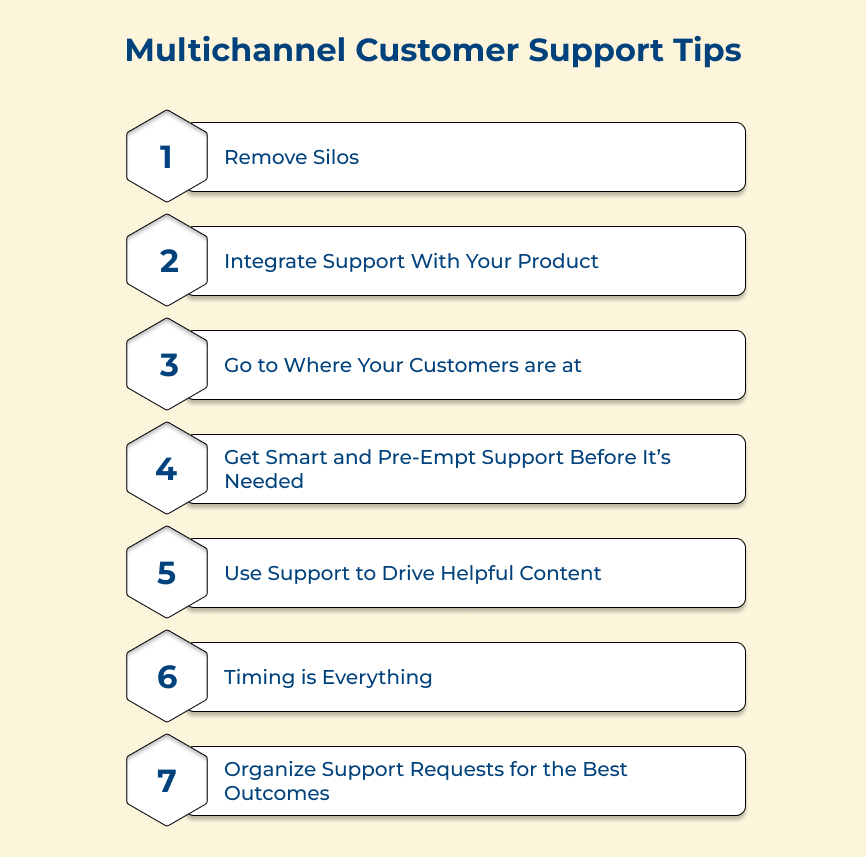
Silos can create inefficiencies and inconsistencies in the customer experience, leading to frustration. Unifying the approach to support allows businesses to ensure that customers receive a consistent and seamless experience. They always receive a consistent experience no matter which channel they choose to interact with the brand.
Removing silos and unifying the approach to support can help streamline communication among different support teams. If a customer reaches out via social media with an issue that requires technical assistance. A unified approach allows the social media team to seamlessly escalate the issue to the technical support team without any delays or miscommunication.
Pro tips:
When building a multichannel customer service strategy, integrating support with the product is crucial for providing a seamless and efficient experience for the customers. The tip involves embedding support functionalities directly within the product. It allows customers to easily access assistance without having to navigate away from the platform.
Integrating support with the product helps to build a multichannel customer support strategy by increasing accessibility and convenience for customers. Let’s take an example of a software company that can integrate a help center directly into their application, providing users with instant access to FAQs. It not only improves the overall user experience but also reduces the workload on customer support teams.
Pro tips:
Businesses must embed support functionalities directly within the product, allowing customers to easily access assistance without having to navigate away from the platform. Integrating support with the product helps to build a multichannel customer support strategy by increasing accessibility and convenience for customers.
Customers can quickly find solutions to their issues without contacting support separately through other channels with support readily available within the product. A software company can integrate a help center directly into their application, providing users with instant access to FAQs, tutorials and troubleshooting guides. It not only improves the overall user experience but also reduces the workload on customer support teams.
Pro tips:
Businesses must emphasize the importance of being proactive and anticipating customer needs before they even arise for building a multichannel customer support strategy. Getting smart and pre-empting support before it’s needed allows businesses to enhance the overall customer experience. It allows businesses to stay one step ahead of customer issues, reducing the likelihood of customer frustration and increasing overall satisfaction.
Anticipating customer needs also shows a level of attentiveness and care that can set a company apart from its competitors. Let’s take am example of a company that could utilize data analytics to predict when a customer may encounter a problem or need assistance with their solutions.
Pro tips:
When it comes to building a multichannel customer support strategy, using support to drive helpful content can be a game-changer. It helps in multichannel customer service implementation by ensuring that customers have access to a wide range of resources across various platforms. Having helpful content readily available can improve customer satisfaction and reduce the burden on the support team.
A use case that can be taken here can be of a software company that creates user guides, FAQ articles and video tutorials to assist customers in troubleshooting common problems. Providing comprehensive support materials allows them to empower customers to find solutions independently, freeing up support agents to handle more complex issues.
Pro tips:
Timing is everything, being known for quick responses emphasizes the importance of responding promptly to customer inquiries across all channels. Providing quick responses allows businesses to ensure a positive customer experience and build trust and loyalty with their customers.
Let’s take an example of a customer who reaches out with a question or concern on social media. When businesses respond promptly, it shows that they value their feedback and are committed to resolving their issue on time. It can result in a satisfied customer who is more likely to recommend the business to others.
Pro tips:
Organizing support requests for the best outcomes for customers is an essential component of building a successful multichannel customer support strategy. Organizing support requests allows customer service teams to effectively prioritize and address incoming inquiries. They can come in from various channels such as phone, email, chat or social media.
Let’s take an example of a retail company that receives a high volume of support requests during a holiday sale. They can use the approach to categorize and prioritize requests based on urgency. It will ensure the customers with pressing issues are attended to promptly.
Pro tips:
Two popular strategies that companies use to engage with customers are multichannel and omnichannel customer service. Both approaches aim to improve the customer experience, there are key differences between the two:
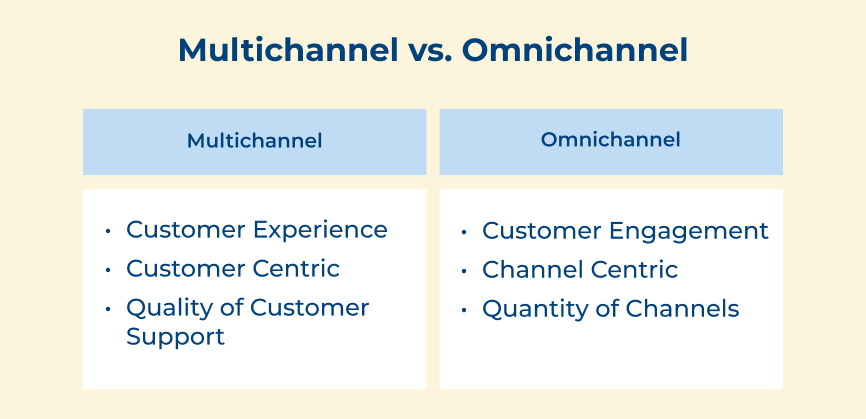
One of the main differences between multichannel and omnichannel customer service is the approach to communication channels. Multichannel customer service involves using multiple channels to interact with customers. The channels operate independently of each other, which can lead to a disjointed experience for the customer.
Omnichannel customer service focuses on creating a seamless, integrated experience for customers across all channels. It means that customer interactions are connected and consistent, regardless of the channel used. Customers can start a conversation on one channel and seamlessly move to another without having to repeat themselves.
Multichannel customer service tends to be more channel-focused, with each channel operating independently and serving a specific purpose. It can offer customers more options for communication, but it can also lead to a fragmented customer journey.
Omnichannel customer service is centered around the customer journey. It takes into account the customer’s experience across all channels, ensuring that interactions are personalized, consistent and relevant. Its approach helps businesses create a more cohesive and engaging customer experience.
When it comes to multichannel customer service, data is often siloed, with each channel storing its information about customer interactions. It can lead to a need for more visibility and coordination between channels, making it difficult to provide a unified customer experience.
Omnichannel customer service involves data sharing and integration across all channels. It allows businesses to track customer interactions, preferences and behavior in real-time, enabling them to deliver a more personalized service. Leveraging customer data across channels allows businesses to create a more seamless and responsive customer experience.
Consistency is key in customer service, it is where multichannel and omnichannel approaches differ. Multichannel customer service has a risk of inconsistencies in messaging and communication across different channels. It can lead to confusion and frustration for customers who expect a cohesive experience.
Omnichannel customer service prioritizes communication consistency. Aligning messaging and branding across all channels allows businesses to ensure that customers receive a unified and on-brand experience. Consistency helps build trust and loyalty among customers, leading to higher satisfaction.
The goal of both multichannel and omnichannel customer service is to improve customer engagement. The approach to achieving this goal differs between the two strategies.
Multichannel customer support focuses on providing customers with more options for communication, which can improve accessibility and convenience. It can lead to increased customer satisfaction, but it may not necessarily cultivate deeper customer relationships.
While customer service across various channels can greatly benefit both businesses and customers, it also comes with its own set of challenges. Here are five common multichannel customer service challenges and solutions to overcome them:
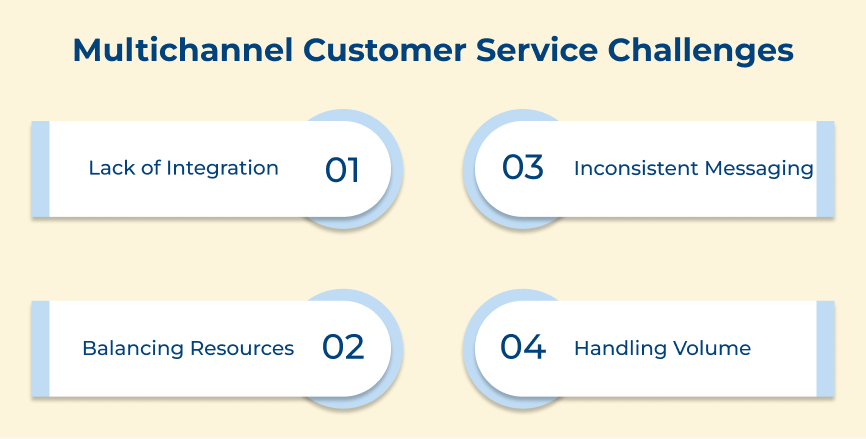
One of the biggest multichannel customer service challenges is the lack of integration between different channels. When customer interactions are not seamlessly connected, it can lead to disjointed experiences and frustrated customers.
Implement a Customer Relationship Management (CRM) system that integrates all channels into one platform. It will allow agents to have a complete view of customer interactions across all channels, enabling them to provide more personalized and efficient service.
Maintaining consistent messaging and branding across multiple channels can be difficult. It happens especially when different teams are managing each channel independently.
Develop clear guidelines and communication strategies for all customer service channels to ensure a consistent brand message. Regularly train and communicate with all customer service representatives to ensure they are aligned with the brand’s messaging.
Managing multiple channels can require a significant investment in resources such as additional staff, technology and training. Balancing the resources effectively can be a challenge for many businesses.
Conduct a thorough analysis of customer preferences and usage patterns across different channels to allocate resources effectively. Utilize automation and self-service options to streamline customer service processes.
Customer service teams are often inundated with a high volume of inquiries with the rise of digital communication channels. It leads to longer response times and potential customer dissatisfaction.
Implement chatbots and automated responses to handle simple common inquiries efficiently. Utilize data analytics to predict peak periods of customer inquiries and staff accordingly to manage volume effectively.
Providing exceptional customer service across all channels is crucial for businesses to thrive. Seamlessly integrating all communication channels from phone calls to social media messages allows businesses to ensure a consistent and efficient customer service experience. Here are the multichannel customer service best practices to know:
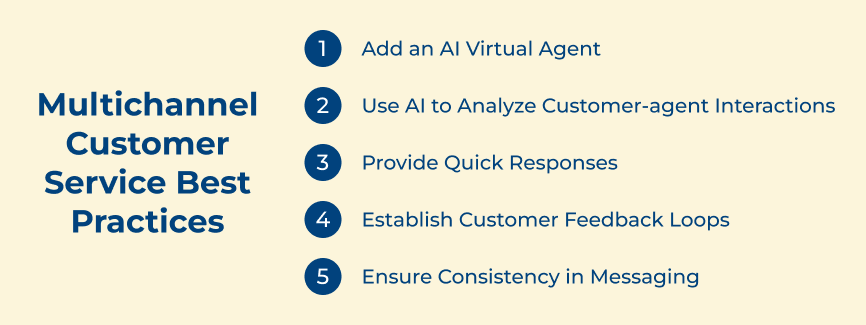
One of the best ways to improve customer service efficiency is by implementing an AI virtual agent. The virtual assistants can handle basic inquiries, provide quick responses and even escalate more complex issues to a human agent when needed. It not only frees up the human agents to focus on more challenging tasks but also ensures that customers receive prompt assistance at any time.
AI technology can be used to analyze customer-agent interactions and identify common issues or pain points. Collecting data on customer interactions allows businesses to gain valuable insights into customer preferences, behaviors and concerns. The information can then be used to improve customer service processes, enhance agent training and streamline overall customer experience.
Customers expect quick responses to their inquiries. Ensuring speedy responses across all channels allows businesses to demonstrate their commitment to customer satisfaction and building trust with their customer base. 71% of consumers believe that a quick response from a service team can drastically improve their customer experience. Utilizing AI technology and automated responses can help businesses meet this demand for efficient communication.
Feedback is essential for continuous improvement in customer service. Establishing customer feedback loops through surveys, follow-up emails or social media polls allows businesses to gather valuable insights into customer satisfaction levels, preferences and areas for improvement. The information can then be used to refine customer service strategies, address issues promptly and enhance overall customer experience.
Consistency is key in the multi-channel customer customer service process. Customers should receive the same level of service and information, regardless of the channel they use to reach out to the business. Ensuring consistency in messaging, tone and branding across all channels allows businesses to create a unified customer service experience that promotes trust.
Customer service has become increasingly important, as consumers expect seamless and convenient experiences across various channels. Here are 5 multi-channel customer support examples of brands that have successfully implemented it:
Starbucks has implemented a multi-channel customer service process by allowing customers to place orders through their mobile app, website, in-store or through social media. Customers can also contact Starbucks through their customer service hotline or email for any inquiries or issues. It has not only streamlined the ordering process for customers but has also increased sales for Starbucks as customers can easily order their favorite drinks and food items
Delta Airlines offers a multichannel customer service approach through its website, mobile app, phone support and social media. Customers can book flights, check in, track their flight status and contact Delta for any assistance they may need. It has improved the overall customer experience for Delta Airlines customers. They can easily access information and assistance through various channels.
Nike has implemented multichannel customer service steps through their website, mobile app, physical stores and social media. Customers can easily reach out to Nike for assistance with their orders, product information or any inquiries they may have. It has helped Nike build stronger relationships with customers and increase customer loyalty. Customers can easily engage with the brand through their preferred channel.
Best Buy offers multichannel customer support through its website, mobile app, in-store support, phone support and social media. Customers can easily contact Best Buy for assistance with their purchases, technical support or any issues they may encounter. It has resulted in improved customer satisfaction and retention for Best Buy. The customers appreciate the convenience of being able to reach out to Best Buy through various channels.
Implementing a multichannel customer support strategy is essential for providing top-tier support across all platforms. Utilizing various communication channels such as phone, email, social media and live chat allows businesses to ensure that they are meeting the diverse needs of their customers.
The approach not only enhances customer satisfaction but also increases efficiency and productivity within the organization. Multichannel customer service allows businesses to effectively manage customer inquiries and resolve issues in a timely manner, eventually building stronger relationships with their customer base. Businesses must prioritize multichannel customer support to stay competitive.
Effective multichannel customer service to the customer means seamless communication and support across various platforms. Customers expect consistent responses and assistance whether they reach out via phone, email, social media or live chat. Timely resolution of issues, personalized interactions and easy access to information are key components of effective multichannel customer support.
Multichannel customer service offers customers the flexibility to choose how they want to interact with a business, whether it’s through phone, email, chat, social media or in-person. The approach increases customer satisfaction, improves customer loyalty and allows businesses to reach a wider audience. Providing multiple channels for communication allows businesses to better meet the diverse preferences of their customers.
Multichannel customer service utilizes multiple communication channels such as phone, email, chat and social media to interact with customers. The approach provides customers with the flexibility to choose how they want to engage with a company, ultimately leading to a more personalized and efficient customer service experience. Offering various options for communication allows businesses to meet the diverse needs and preferences of their customers.
Companies should invest in a robust customer relationship management (CRM) system that integrates all communication channels into one platform. It allows customer service agents to easily track customer interactions across channels and provide consistent, personalized support.
Market better, sell faster and support smarter with Veemo’s Conversation Customer Engagement suite of products.
Unify all your customer data in one platform to deliver contextual responses. Get a 360 degree view of the customer lifecycle without switching tools.
Connect with the tools you love to reduce manual activities and sync your business workflows for a seamless experience.
 https://veemo.io/wp-content/uploads/2024/02/Live-Chat-for-Sales.png
628
1200
Harsh Patel
https://veemo.io/wp-content/uploads/2023/03/Vector-1.svg
Harsh Patel2024-10-21 11:31:222024-10-23 12:32:34Live Chat For Sales: How to Leverage Live Chat to Boost Revenue?
https://veemo.io/wp-content/uploads/2024/02/Live-Chat-for-Sales.png
628
1200
Harsh Patel
https://veemo.io/wp-content/uploads/2023/03/Vector-1.svg
Harsh Patel2024-10-21 11:31:222024-10-23 12:32:34Live Chat For Sales: How to Leverage Live Chat to Boost Revenue? https://veemo.io/wp-content/uploads/2024/02/Ecommerce-Customer-Journey-2.png
628
1200
Harsh Patel
https://veemo.io/wp-content/uploads/2023/03/Vector-1.svg
Harsh Patel2024-10-20 14:05:172024-10-23 12:14:49Ecommerce Customer Journey: Steps to Build a Seamless Experience
https://veemo.io/wp-content/uploads/2024/02/Ecommerce-Customer-Journey-2.png
628
1200
Harsh Patel
https://veemo.io/wp-content/uploads/2023/03/Vector-1.svg
Harsh Patel2024-10-20 14:05:172024-10-23 12:14:49Ecommerce Customer Journey: Steps to Build a Seamless Experience
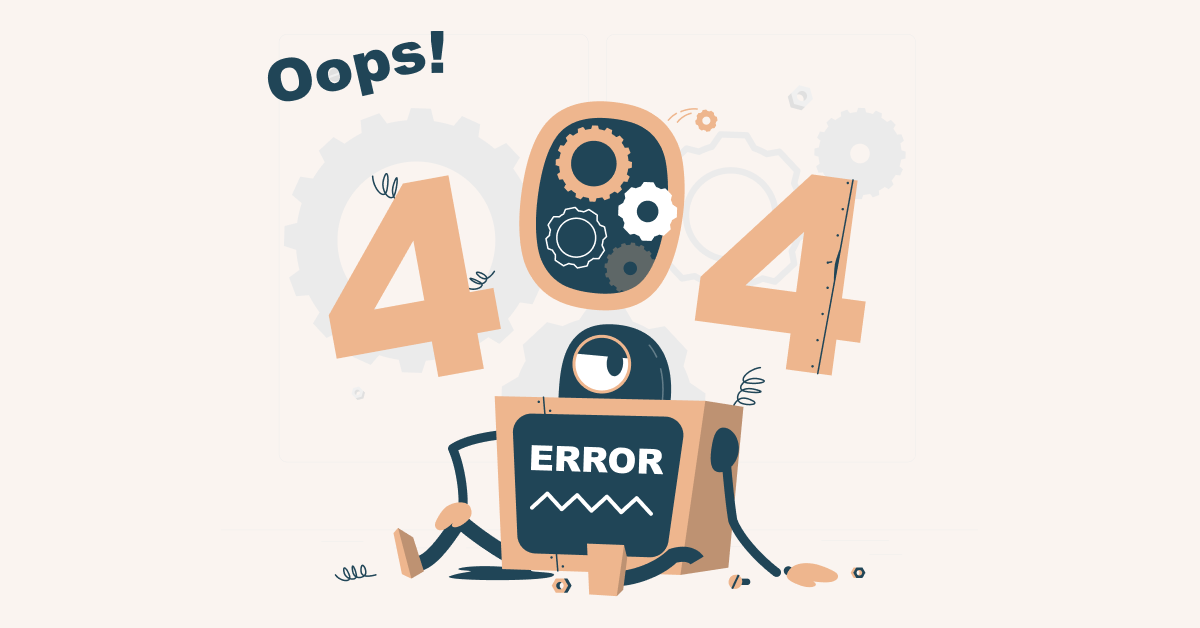 Chatbot Fails: Reasons, Solutions and Examples
Scroll to top
Chatbot Fails: Reasons, Solutions and Examples
Scroll to top